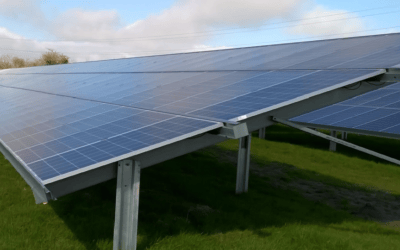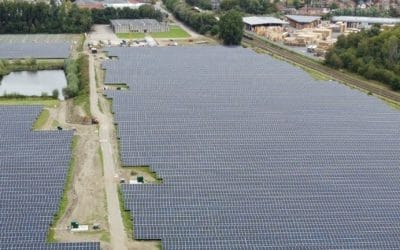Businesses across the UK continue to feel the pressure of spiralling energy costs and are increasingly looking at ways to reduce their expenditure. As well as taking steps to reduce waste and better manage how energy is being used, one of the key ways businesses can make reductions is to take action ‘behind the meter’.
What does ‘behind the meter’ mean?
Commercial organisations will typically have a gas and electricity meter and receive energy via a utility, such as British Gas, SSE or E.ON. These meters will measure how much energy is being used and a bill will be issued accordingly.
Taking action ‘behind the meter’ refers to anything that can be done to reduce the amount of energy being purchased this way, i.e. from a utility. For example, by making energy efficiency upgrades to reduce usage, installing renewable technologies to generate energy onsite and promoting behavioural changes – anything which has a positive impact on the overall level of energy being consumed.
Why is it important?
Commercial energy bills are on the rise and this trend is set to continue:
Energy tariffs are increasing
The cost of purchasing energy from the grid continues to increase year-on-year. Electricity and gas prices have doubled over the past seven years and if the price rises continue in line with previous years, then bills could increase 70% over the next three years, according to BusinessEnergy.com.
Energy policy compliance
Added to this is the need to comply with UK energy policy, which often comes at a cost. Business and industry accounts for approximately 25 per cent of the UK’s carbon emissions. This has seen a raft of legislation introduced, which aims to encourage – and in some circumstances force – businesses to take steps to reduce their carbon emissions.
The government continues to introduce and amend such legislation. One upcoming change being the termination of The Carbon Reduction Commitment (CRC), which is being replaced by an increase in the Climate Change Levy (CCL). Through CCL, businesses pay tax on the energy they take from the grid. The more they use, the more they will pay.
What are the potential benefits?
According to the Government’s Clean Growth Strategy, the financial savings could be substantial:
- Up to £6 billion could be saved by business and industry by 2030 through investment in cost-effective energy efficiency technologies
- Roughly half of these savings could be made through improving the efficiency of buildings and processes, including better insulation and smarter energy controls
- The other half could be realised through eliminating electricity waste, such as by using better lighting and implementing energy management systems
What is behind the meter generation?
One way businesses can reduce their energy costs is to generate their own power. A behind the meter generation system is a renewable energy generating facility, such as solar PV, that produces power on site. As the power is being generated by the business, not produced on the side of the grid, it is referred to as ‘behind the meter’. Such systems range from the small and simple to the large and complex, but the flexible nature of such solutions means they can work for a range of businesses.
As our earlier example showed, one additional benefit is that revenue can also be generated from any surplus energy that is fed back into the grid. Payments may also be made under the Renewable Heat Incentive (RHI) scheme for heat generated from a renewable source.
What is behind the meter energy storage?
In the same way, energy storage solutions can also be installed and used on site. This type of unit can store energy generated by a behind the meter generation system, such as solar PV, Combined Heat Power (CHP) unit, or a wind turbine, then release it when it is needed. For example, at night when a solar installation may not be generating. Again, any excess energy can be fed back into the grid, helping to balance supply and demand and generating additional revenue in the process.
Popular energy efficiency technologies
Some of the most popular and effective energy efficiency measures and technologies being implemented by businesses, include:
- Energy efficient light fittings and controls
- Insulation
- Building management systems
- Business solar panels
- Biomass boilers
- Energy storage units
- Heat pumps
- Combined heat and power (CHP) systems
All these upgrades fall under the umbrella term of energy conservation measures (ECMs). While such technologies can bring savings when used in isolation, the most efficient way to reduce energy usage is to combine them.
For example:
An office-based business in which lighting and computer terminals are among the main energy draws, may consider the following:
Retrofitting an energy efficient lighting scheme could save them up to 30% on their annual expenditure. However, if these upgrades were combined with commercial solar pv panels, which generated all, or some, of the daytime electricity needed to power the lights and computers, then these savings could be substantially increased. The solar pv installation will not only displace purchased electrical energy from the grid, but also receive payments from the government through the non domestic solar feed in tariffs (FiTs), for any excess energy generated that is fed back into the grid.
Funding upgrades and measures
There are two main funding routes for businesses wishing to make behind the meter upgrades:
Self-funded
All the measures and upgrades can be paid for in full by the company. This means that all the savings and any additional revenue generated (such as through FiTs and RHI) will go directly to the company. Part of the planning process should include a report on all potential measures, the payback periods, estimated savings and any incentives that are available.
Fully-funded
For those who don’t have the upfront capital needed, or who simply prefer this route, a fully funded option may be an option. Some project developers, such as Anesco, will cover the cost of such projects and recoup it through the energy savings achieved. At the end of the agreement, ownership of the upgrades and the full benefit of the savings will then pass back to the company.
Who could benefit from taking action behind the meter?
Whatever the nature of the business or industry may be, if energy costs make up a significant part of expenditure then taking action behind the meter could bring considerable benefits. The broad range of measures and technologies that are available mean there is no ‘one size fits all’, the secret lies in examining current energy use, seeing where improvements could be made and ensuring the maximum impact of any upgrades is achieved.
You may also be interested in:
- How to improve workplace lighting and reduce energy consumption
- Minimum Energy Efficiency Standard (MEES): a complete guide for businesses
Anesco is the UK’s leading energy efficiency company and works with businesses of all sizes and across all industries. For specialist advice and information on reducing commercial carbon emissions and improving energy efficiency, contact the Anesco Commercial & Industrial team for an informal chat on 0845 894 44 44.






